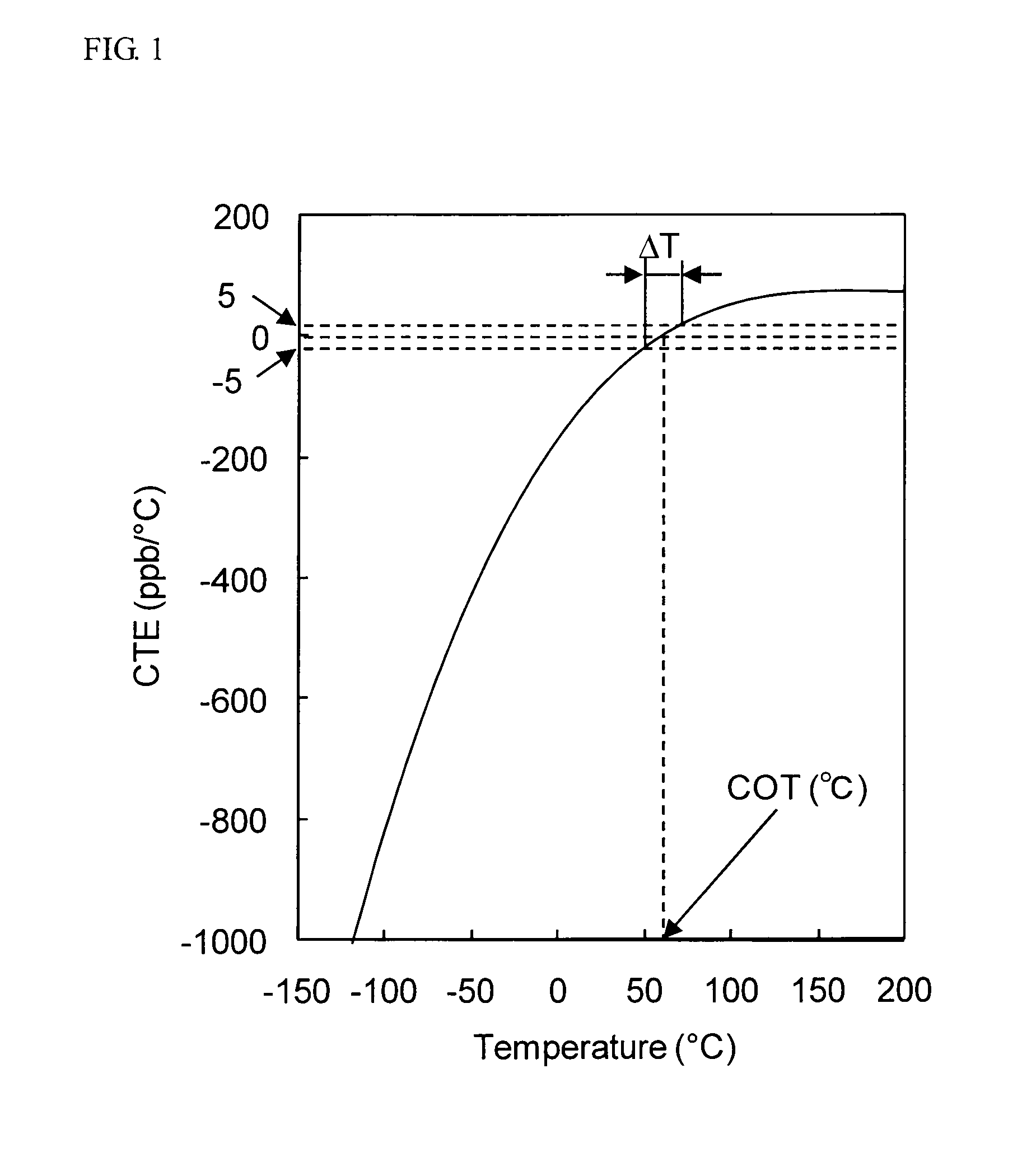Tio2-containing silica glass and optical member for lithography using the same
a technology of optical components and silica glass, which is applied in the field of tio2containing silica glass and optical components for lithography using the same, can solve the problems of complicated optical design of optical components, and achieve the effects of increasing the throughput of exposure tools, preventing a change in the pitch of patterns, and increasing the euv light energy
- Summary
- Abstract
- Description
- Claims
- Application Information
AI Technical Summary
Benefits of technology
Problems solved by technology
Method used
Image
Examples
example 1
[0088]TiO2—SiO2 glass fine particles obtainable by gasifying TiCl4 and SiCl4 each serving as a glass-forming raw material of a TiO2—SiO2 glass, respectively and then mixing them and subjecting the mixture to heat hydrolysis (flame hydrolysis) in an oxyhydrogen flame is deposited and grown on a substrate, thereby forming a porous TiO2—SiO2 glass body (step (a)).
[0089]Since it is hard to handle the obtained porous TiO2—SiO2 glass body without any treatment, the obtained porous TiO2—SiO2 glass body is kept in air at 1,200° C. for 4 hours together with substrate and then separated from the substrate.
[0090]Thereafter, the porous TiO2—SiO2 glass body is placed in an atmosphere-controllable electric furnace, and the pressure is reduced to 1,333 Pa at room temperature. Thereafter, the resulting porous TiO2—SiO2 glass body is kept in this atmosphere at 1,100° C. under normal pressure for 4 hours while introducing a mixed gas of He and SiF4 in a ratio 90 / 10 (by volume), thereby effecting dopi...
example 2
[0095]TiO2—SiO2 glass fine particles obtainable by gasifying TiCl4 and SiCl4 each serving as a glass-forming raw material of a TiO2—SiO2 glass, respectively and then mixing them and subjecting the mixture to heat hydrolysis (flame hydrolysis) in an oxyhydrogen flame is deposited and grown on a substrate, thereby forming a porous TiO2—SiO2 glass body (step (a)).
[0096]Since it is hard to handle the obtained porous TiO2—SiO2 glass body without any treatment, the obtained porous TiO2—SiO2 glass body is kept in air at 1,200° C. for 4 hours together with the substrate and then separated from the substrate.
[0097]Thereafter, the porous TiO2—SiO2 glass body is placed in an atmosphere-controllable electric furnace, and the pressure is reduced to 1,333 Pa at room temperature. Thereafter, a mixed gas of He and SiF4 in a ratio 90 / 10 (by volume) is introduced; the pressure is again reduced to 1,333 Pa; and thereafter, a mixed gas of He and SiF4 in a ratio 90 / 10 (by volume) is introduced. After re...
example 3
[0102]TiO2—SiO2 glass fine particles obtainable by gasifying TiCl4 and SiCl4 each serving as a glass-forming raw material of a TiO2—SiO2 glass, respectively and then mixing them and subjecting the mixture to heat hydrolysis (flame hydrolysis) in an oxyhydrogen flame is deposited and grown on a substrate, thereby forming a porous TiO2—SiO2 glass body (step (a)).
[0103]Since it is hard to handle the obtained porous TiO2—SiO2 glass body without any treatment, the obtained porous TiO2—SiO2 glass body is kept in air at 1,200° C. for 4 hours together with the substrate and then separated from the substrate.
[0104]Thereafter, the porous TiO2—SiO2 glass body is placed in an atmosphere-controllable electric furnace, and the pressure is reduced to 1,333 Pa at room temperature. Thereafter, the resulting porous TiO2—SiO2 glass body is kept in this atmosphere at 1,100° C. under normal pressure for 4 hours while introducing a mixed gas of He and SiF4 in a ratio 90 / 10 (by volume), thereby effecting ...
PUM
| Property | Measurement | Unit |
|---|---|---|
| fictive temperature | aaaaa | aaaaa |
| wavelength | aaaaa | aaaaa |
| wavelength | aaaaa | aaaaa |
Abstract
Description
Claims
Application Information
 Login to View More
Login to View More - R&D
- Intellectual Property
- Life Sciences
- Materials
- Tech Scout
- Unparalleled Data Quality
- Higher Quality Content
- 60% Fewer Hallucinations
Browse by: Latest US Patents, China's latest patents, Technical Efficacy Thesaurus, Application Domain, Technology Topic, Popular Technical Reports.
© 2025 PatSnap. All rights reserved.Legal|Privacy policy|Modern Slavery Act Transparency Statement|Sitemap|About US| Contact US: help@patsnap.com


